Internationalisation Strategy of HAIER Group: A Case Study
VerifiedAdded on 2023/06/03
|15
|3810
|288
Case Study
AI Summary
This case study provides an in-depth analysis of HAIER Group's internationalisation strategy since the early 1990s, highlighting its unique features and how it differs from typical Western initiatives. It evaluates the effectiveness of HAIER's policies, examining its expansion into America, Europe, and the Asia-Pacific region. The study also explores HAIER's management system, comparing its philosophies to those of Western companies and drawing valuable lessons for both Chinese and Western enterprises. The case study concludes by summarizing the key factors contributing to HAIER's success and its significance in the global market.
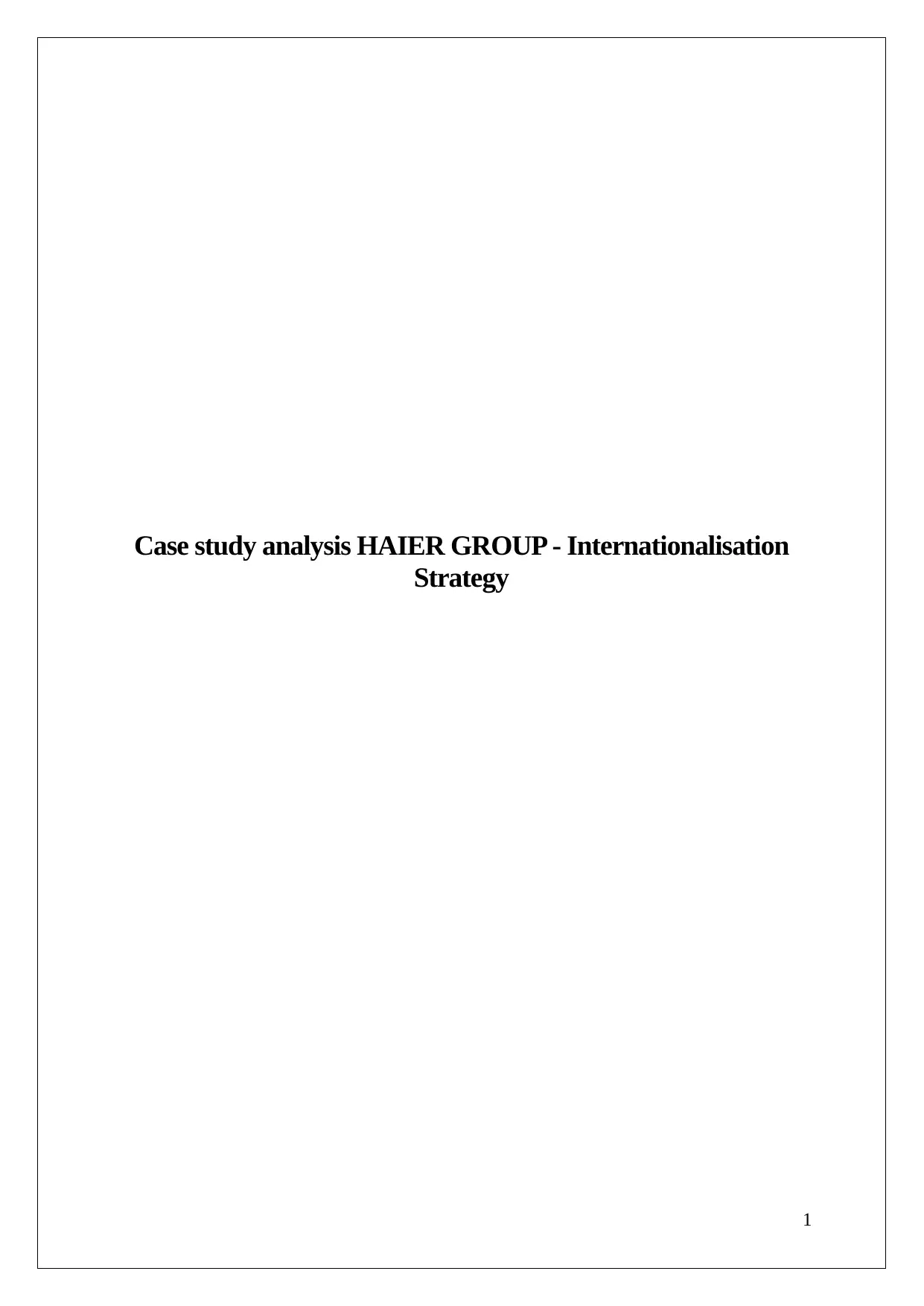
Case study analysis HAIER GROUP - Internationalisation
Strategy
1
Strategy
1
Paraphrase This Document
Need a fresh take? Get an instant paraphrase of this document with our AI Paraphraser

Table of Contents
Introduction................................................................................................................................3
1. What are the main features of Haier’s internationalisation strategy since the early 1990s?
4
2. How does Haier’s internationalisation policy vary from the outline of international
growth typical of Western initiatives?.......................................................................................6
3. How effective has Haier’s internationalisation policy been and why?..................................9
4. What are the main structures and specificities of Haier’s management system?.............11
In what ways do Haier’s philosophies and approaches of management vary from those
deployed by Western companies?............................................................................................11
What lessons might be drawn by a) other Chinese companies and b) by Western enterprises?
..................................................................................................................................................12
Conclusion................................................................................................................................13
Reference list............................................................................................................................14
2
Introduction................................................................................................................................3
1. What are the main features of Haier’s internationalisation strategy since the early 1990s?
4
2. How does Haier’s internationalisation policy vary from the outline of international
growth typical of Western initiatives?.......................................................................................6
3. How effective has Haier’s internationalisation policy been and why?..................................9
4. What are the main structures and specificities of Haier’s management system?.............11
In what ways do Haier’s philosophies and approaches of management vary from those
deployed by Western companies?............................................................................................11
What lessons might be drawn by a) other Chinese companies and b) by Western enterprises?
..................................................................................................................................................12
Conclusion................................................................................................................................13
Reference list............................................................................................................................14
2

Introduction
The strategic conversion of the bankrupt Qingdao General Refrigerator Factory into the Haier
Group, one of the world’s largest and affordable household appliance organizations, is a
classic example, which symbolized China’s development to become one of the globe’s
leading manufacturing centre as well as main source of FDI (Foreign direct investment)
(haier.net, 2018). Up till now, the success story of Haier is also an atypical of China’s
manufacturing development. By the year 2015, it had attained an international position,
which had eluded most of the other domestic and state-owned organizations. With this
success, Haier has become now one of the leading international brand, a frontrunner in terms
of product design, innovation and others. This study will indulge in investigating the
background details of this industrial success and strategic management of Haier.
3
The strategic conversion of the bankrupt Qingdao General Refrigerator Factory into the Haier
Group, one of the world’s largest and affordable household appliance organizations, is a
classic example, which symbolized China’s development to become one of the globe’s
leading manufacturing centre as well as main source of FDI (Foreign direct investment)
(haier.net, 2018). Up till now, the success story of Haier is also an atypical of China’s
manufacturing development. By the year 2015, it had attained an international position,
which had eluded most of the other domestic and state-owned organizations. With this
success, Haier has become now one of the leading international brand, a frontrunner in terms
of product design, innovation and others. This study will indulge in investigating the
background details of this industrial success and strategic management of Haier.
3
⊘ This is a preview!⊘
Do you want full access?
Subscribe today to unlock all pages.

Trusted by 1+ million students worldwide
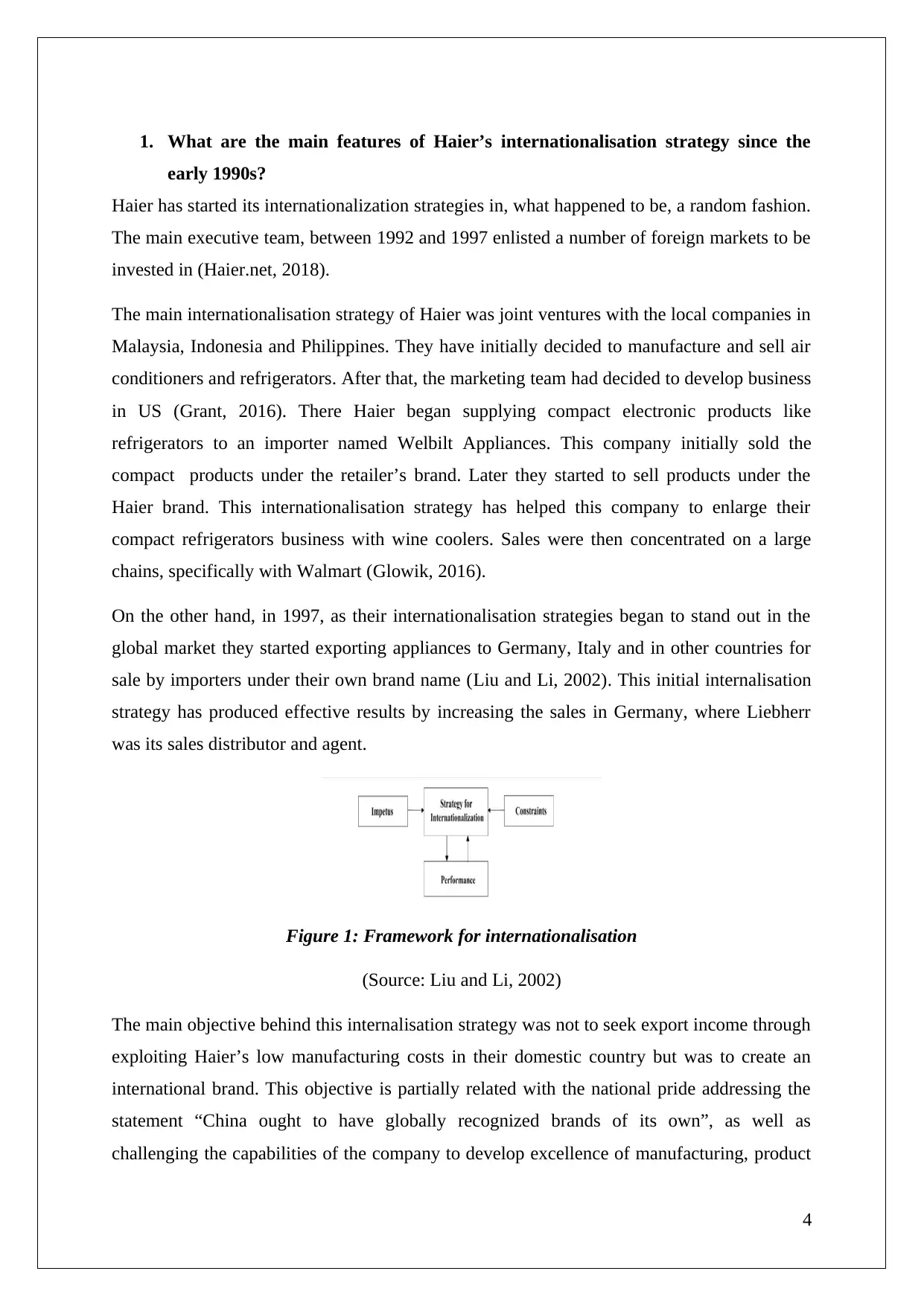
1. What are the main features of Haier’s internationalisation strategy since the
early 1990s?
Haier has started its internationalization strategies in, what happened to be, a random fashion.
The main executive team, between 1992 and 1997 enlisted a number of foreign markets to be
invested in (Haier.net, 2018).
The main internationalisation strategy of Haier was joint ventures with the local companies in
Malaysia, Indonesia and Philippines. They have initially decided to manufacture and sell air
conditioners and refrigerators. After that, the marketing team had decided to develop business
in US (Grant, 2016). There Haier began supplying compact electronic products like
refrigerators to an importer named Welbilt Appliances. This company initially sold the
compact products under the retailer’s brand. Later they started to sell products under the
Haier brand. This internationalisation strategy has helped this company to enlarge their
compact refrigerators business with wine coolers. Sales were then concentrated on a large
chains, specifically with Walmart (Glowik, 2016).
On the other hand, in 1997, as their internationalisation strategies began to stand out in the
global market they started exporting appliances to Germany, Italy and in other countries for
sale by importers under their own brand name (Liu and Li, 2002). This initial internalisation
strategy has produced effective results by increasing the sales in Germany, where Liebherr
was its sales distributor and agent.
Figure 1: Framework for internationalisation
(Source: Liu and Li, 2002)
The main objective behind this internalisation strategy was not to seek export income through
exploiting Haier’s low manufacturing costs in their domestic country but was to create an
international brand. This objective is partially related with the national pride addressing the
statement “China ought to have globally recognized brands of its own”, as well as
challenging the capabilities of the company to develop excellence of manufacturing, product
4
early 1990s?
Haier has started its internationalization strategies in, what happened to be, a random fashion.
The main executive team, between 1992 and 1997 enlisted a number of foreign markets to be
invested in (Haier.net, 2018).
The main internationalisation strategy of Haier was joint ventures with the local companies in
Malaysia, Indonesia and Philippines. They have initially decided to manufacture and sell air
conditioners and refrigerators. After that, the marketing team had decided to develop business
in US (Grant, 2016). There Haier began supplying compact electronic products like
refrigerators to an importer named Welbilt Appliances. This company initially sold the
compact products under the retailer’s brand. Later they started to sell products under the
Haier brand. This internationalisation strategy has helped this company to enlarge their
compact refrigerators business with wine coolers. Sales were then concentrated on a large
chains, specifically with Walmart (Glowik, 2016).
On the other hand, in 1997, as their internationalisation strategies began to stand out in the
global market they started exporting appliances to Germany, Italy and in other countries for
sale by importers under their own brand name (Liu and Li, 2002). This initial internalisation
strategy has produced effective results by increasing the sales in Germany, where Liebherr
was its sales distributor and agent.
Figure 1: Framework for internationalisation
(Source: Liu and Li, 2002)
The main objective behind this internalisation strategy was not to seek export income through
exploiting Haier’s low manufacturing costs in their domestic country but was to create an
international brand. This objective is partially related with the national pride addressing the
statement “China ought to have globally recognized brands of its own”, as well as
challenging the capabilities of the company to develop excellence of manufacturing, product
4
Paraphrase This Document
Need a fresh take? Get an instant paraphrase of this document with our AI Paraphraser
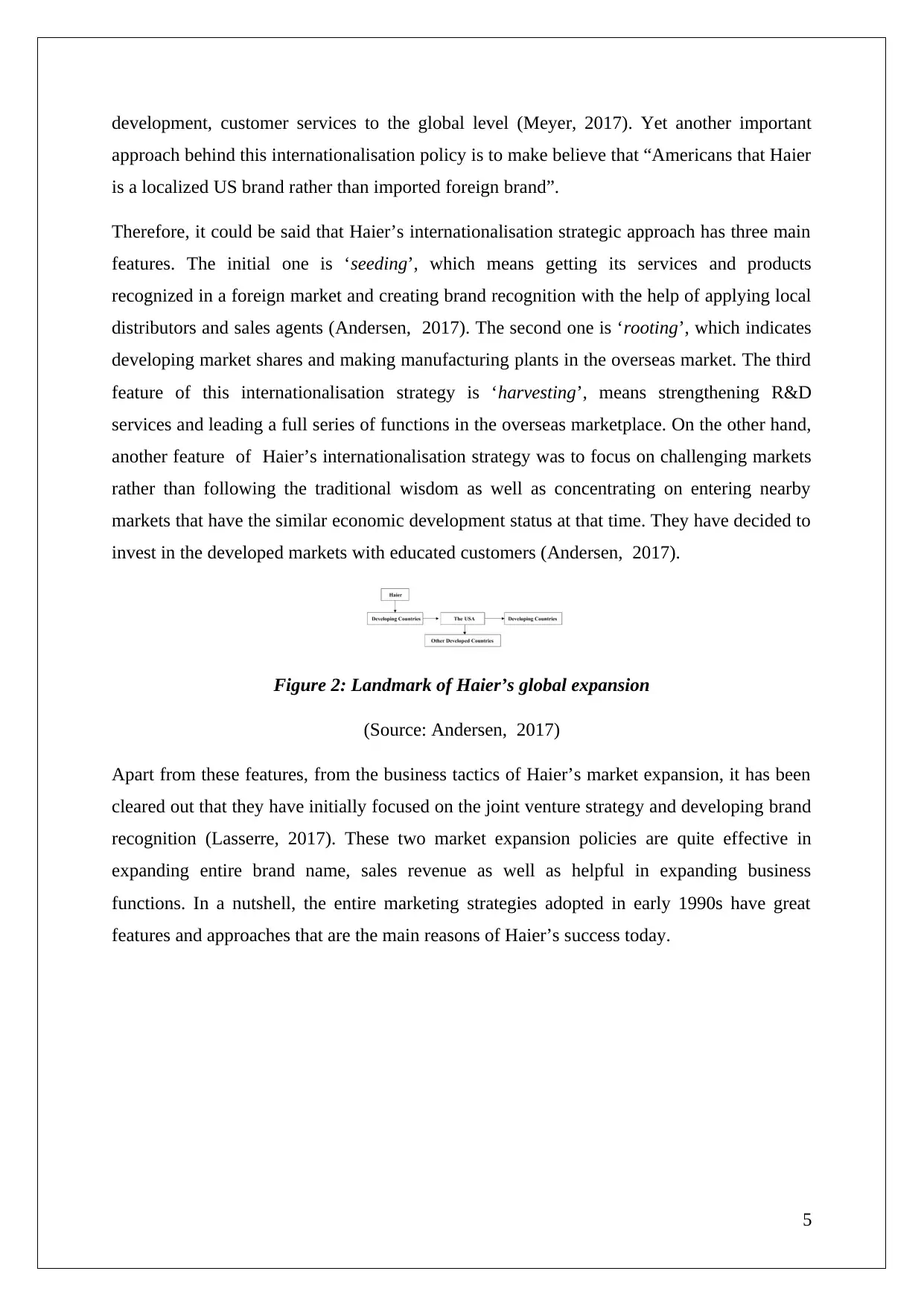
development, customer services to the global level (Meyer, 2017). Yet another important
approach behind this internationalisation policy is to make believe that “Americans that Haier
is a localized US brand rather than imported foreign brand”.
Therefore, it could be said that Haier’s internationalisation strategic approach has three main
features. The initial one is ‘seeding’, which means getting its services and products
recognized in a foreign market and creating brand recognition with the help of applying local
distributors and sales agents (Andersen, 2017). The second one is ‘rooting’, which indicates
developing market shares and making manufacturing plants in the overseas market. The third
feature of this internationalisation strategy is ‘harvesting’, means strengthening R&D
services and leading a full series of functions in the overseas marketplace. On the other hand,
another feature of Haier’s internationalisation strategy was to focus on challenging markets
rather than following the traditional wisdom as well as concentrating on entering nearby
markets that have the similar economic development status at that time. They have decided to
invest in the developed markets with educated customers (Andersen, 2017).
Figure 2: Landmark of Haier’s global expansion
(Source: Andersen, 2017)
Apart from these features, from the business tactics of Haier’s market expansion, it has been
cleared out that they have initially focused on the joint venture strategy and developing brand
recognition (Lasserre, 2017). These two market expansion policies are quite effective in
expanding entire brand name, sales revenue as well as helpful in expanding business
functions. In a nutshell, the entire marketing strategies adopted in early 1990s have great
features and approaches that are the main reasons of Haier’s success today.
5
approach behind this internationalisation policy is to make believe that “Americans that Haier
is a localized US brand rather than imported foreign brand”.
Therefore, it could be said that Haier’s internationalisation strategic approach has three main
features. The initial one is ‘seeding’, which means getting its services and products
recognized in a foreign market and creating brand recognition with the help of applying local
distributors and sales agents (Andersen, 2017). The second one is ‘rooting’, which indicates
developing market shares and making manufacturing plants in the overseas market. The third
feature of this internationalisation strategy is ‘harvesting’, means strengthening R&D
services and leading a full series of functions in the overseas marketplace. On the other hand,
another feature of Haier’s internationalisation strategy was to focus on challenging markets
rather than following the traditional wisdom as well as concentrating on entering nearby
markets that have the similar economic development status at that time. They have decided to
invest in the developed markets with educated customers (Andersen, 2017).
Figure 2: Landmark of Haier’s global expansion
(Source: Andersen, 2017)
Apart from these features, from the business tactics of Haier’s market expansion, it has been
cleared out that they have initially focused on the joint venture strategy and developing brand
recognition (Lasserre, 2017). These two market expansion policies are quite effective in
expanding entire brand name, sales revenue as well as helpful in expanding business
functions. In a nutshell, the entire marketing strategies adopted in early 1990s have great
features and approaches that are the main reasons of Haier’s success today.
5
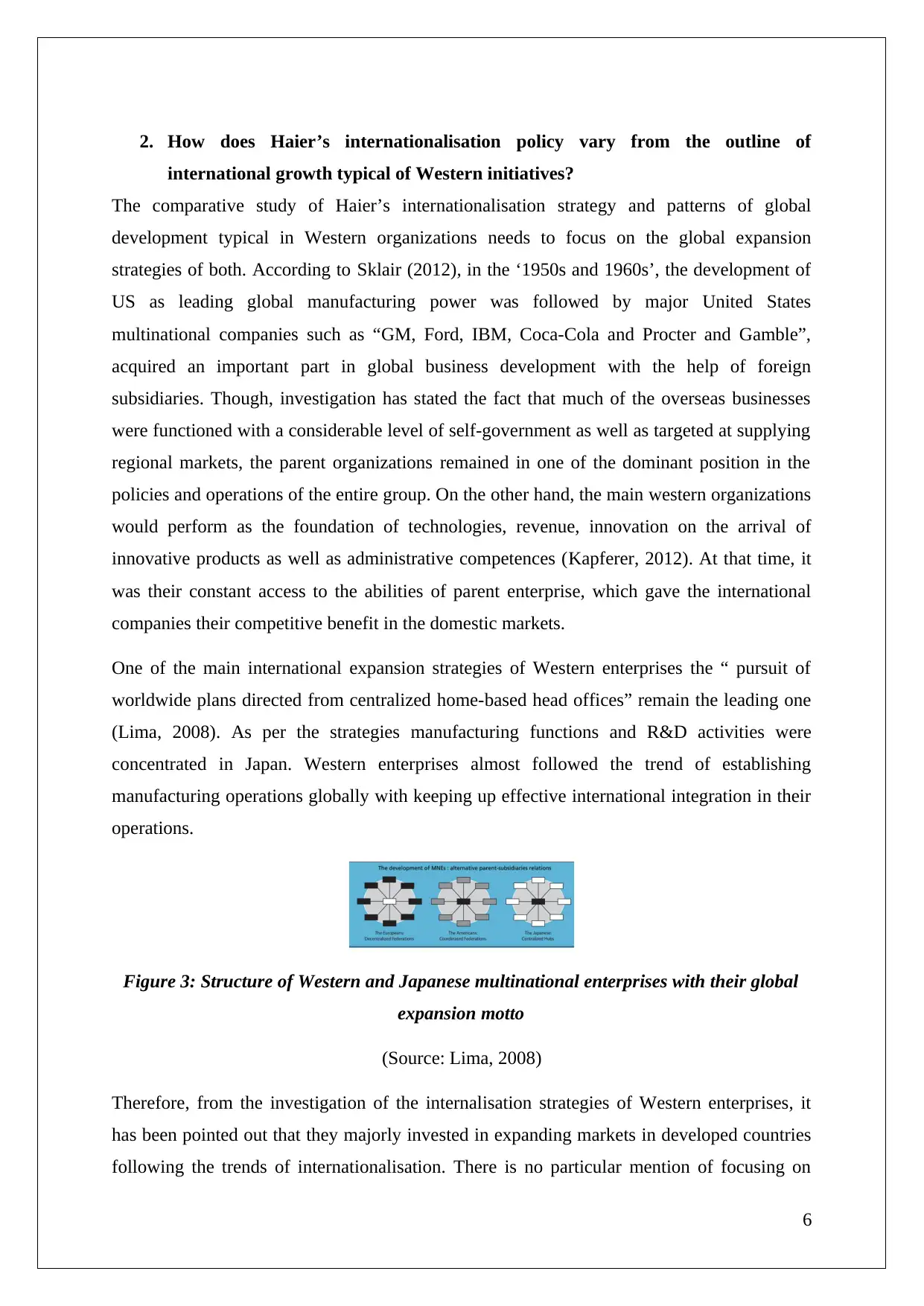
2. How does Haier’s internationalisation policy vary from the outline of
international growth typical of Western initiatives?
The comparative study of Haier’s internationalisation strategy and patterns of global
development typical in Western organizations needs to focus on the global expansion
strategies of both. According to Sklair (2012), in the ‘1950s and 1960s’, the development of
US as leading global manufacturing power was followed by major United States
multinational companies such as “GM, Ford, IBM, Coca-Cola and Procter and Gamble”,
acquired an important part in global business development with the help of foreign
subsidiaries. Though, investigation has stated the fact that much of the overseas businesses
were functioned with a considerable level of self-government as well as targeted at supplying
regional markets, the parent organizations remained in one of the dominant position in the
policies and operations of the entire group. On the other hand, the main western organizations
would perform as the foundation of technologies, revenue, innovation on the arrival of
innovative products as well as administrative competences (Kapferer, 2012). At that time, it
was their constant access to the abilities of parent enterprise, which gave the international
companies their competitive benefit in the domestic markets.
One of the main international expansion strategies of Western enterprises the “ pursuit of
worldwide plans directed from centralized home-based head offices” remain the leading one
(Lima, 2008). As per the strategies manufacturing functions and R&D activities were
concentrated in Japan. Western enterprises almost followed the trend of establishing
manufacturing operations globally with keeping up effective international integration in their
operations.
Figure 3: Structure of Western and Japanese multinational enterprises with their global
expansion motto
(Source: Lima, 2008)
Therefore, from the investigation of the internalisation strategies of Western enterprises, it
has been pointed out that they majorly invested in expanding markets in developed countries
following the trends of internationalisation. There is no particular mention of focusing on
6
international growth typical of Western initiatives?
The comparative study of Haier’s internationalisation strategy and patterns of global
development typical in Western organizations needs to focus on the global expansion
strategies of both. According to Sklair (2012), in the ‘1950s and 1960s’, the development of
US as leading global manufacturing power was followed by major United States
multinational companies such as “GM, Ford, IBM, Coca-Cola and Procter and Gamble”,
acquired an important part in global business development with the help of foreign
subsidiaries. Though, investigation has stated the fact that much of the overseas businesses
were functioned with a considerable level of self-government as well as targeted at supplying
regional markets, the parent organizations remained in one of the dominant position in the
policies and operations of the entire group. On the other hand, the main western organizations
would perform as the foundation of technologies, revenue, innovation on the arrival of
innovative products as well as administrative competences (Kapferer, 2012). At that time, it
was their constant access to the abilities of parent enterprise, which gave the international
companies their competitive benefit in the domestic markets.
One of the main international expansion strategies of Western enterprises the “ pursuit of
worldwide plans directed from centralized home-based head offices” remain the leading one
(Lima, 2008). As per the strategies manufacturing functions and R&D activities were
concentrated in Japan. Western enterprises almost followed the trend of establishing
manufacturing operations globally with keeping up effective international integration in their
operations.
Figure 3: Structure of Western and Japanese multinational enterprises with their global
expansion motto
(Source: Lima, 2008)
Therefore, from the investigation of the internalisation strategies of Western enterprises, it
has been pointed out that they majorly invested in expanding markets in developed countries
following the trends of internationalisation. There is no particular mention of focusing on
6
⊘ This is a preview!⊘
Do you want full access?
Subscribe today to unlock all pages.

Trusted by 1+ million students worldwide
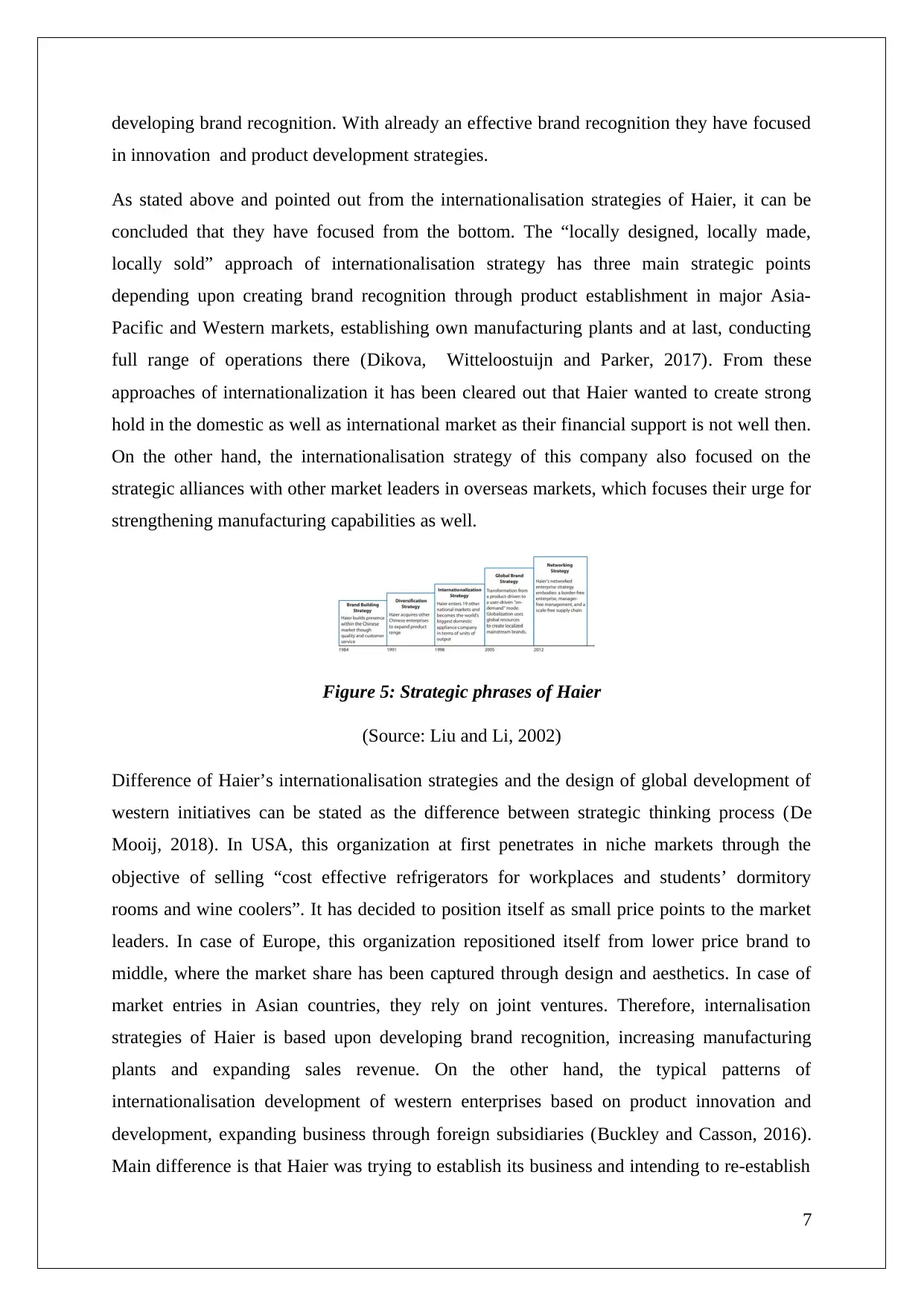
developing brand recognition. With already an effective brand recognition they have focused
in innovation and product development strategies.
As stated above and pointed out from the internationalisation strategies of Haier, it can be
concluded that they have focused from the bottom. The “locally designed, locally made,
locally sold” approach of internationalisation strategy has three main strategic points
depending upon creating brand recognition through product establishment in major Asia-
Pacific and Western markets, establishing own manufacturing plants and at last, conducting
full range of operations there (Dikova, Witteloostuijn and Parker, 2017). From these
approaches of internationalization it has been cleared out that Haier wanted to create strong
hold in the domestic as well as international market as their financial support is not well then.
On the other hand, the internationalisation strategy of this company also focused on the
strategic alliances with other market leaders in overseas markets, which focuses their urge for
strengthening manufacturing capabilities as well.
Figure 5: Strategic phrases of Haier
(Source: Liu and Li, 2002)
Difference of Haier’s internationalisation strategies and the design of global development of
western initiatives can be stated as the difference between strategic thinking process (De
Mooij, 2018). In USA, this organization at first penetrates in niche markets through the
objective of selling “cost effective refrigerators for workplaces and students’ dormitory
rooms and wine coolers”. It has decided to position itself as small price points to the market
leaders. In case of Europe, this organization repositioned itself from lower price brand to
middle, where the market share has been captured through design and aesthetics. In case of
market entries in Asian countries, they rely on joint ventures. Therefore, internalisation
strategies of Haier is based upon developing brand recognition, increasing manufacturing
plants and expanding sales revenue. On the other hand, the typical patterns of
internationalisation development of western enterprises based on product innovation and
development, expanding business through foreign subsidiaries (Buckley and Casson, 2016).
Main difference is that Haier was trying to establish its business and intending to re-establish
7
in innovation and product development strategies.
As stated above and pointed out from the internationalisation strategies of Haier, it can be
concluded that they have focused from the bottom. The “locally designed, locally made,
locally sold” approach of internationalisation strategy has three main strategic points
depending upon creating brand recognition through product establishment in major Asia-
Pacific and Western markets, establishing own manufacturing plants and at last, conducting
full range of operations there (Dikova, Witteloostuijn and Parker, 2017). From these
approaches of internationalization it has been cleared out that Haier wanted to create strong
hold in the domestic as well as international market as their financial support is not well then.
On the other hand, the internationalisation strategy of this company also focused on the
strategic alliances with other market leaders in overseas markets, which focuses their urge for
strengthening manufacturing capabilities as well.
Figure 5: Strategic phrases of Haier
(Source: Liu and Li, 2002)
Difference of Haier’s internationalisation strategies and the design of global development of
western initiatives can be stated as the difference between strategic thinking process (De
Mooij, 2018). In USA, this organization at first penetrates in niche markets through the
objective of selling “cost effective refrigerators for workplaces and students’ dormitory
rooms and wine coolers”. It has decided to position itself as small price points to the market
leaders. In case of Europe, this organization repositioned itself from lower price brand to
middle, where the market share has been captured through design and aesthetics. In case of
market entries in Asian countries, they rely on joint ventures. Therefore, internalisation
strategies of Haier is based upon developing brand recognition, increasing manufacturing
plants and expanding sales revenue. On the other hand, the typical patterns of
internationalisation development of western enterprises based on product innovation and
development, expanding business through foreign subsidiaries (Buckley and Casson, 2016).
Main difference is that Haier was trying to establish its business and intending to re-establish
7
Paraphrase This Document
Need a fresh take? Get an instant paraphrase of this document with our AI Paraphraser
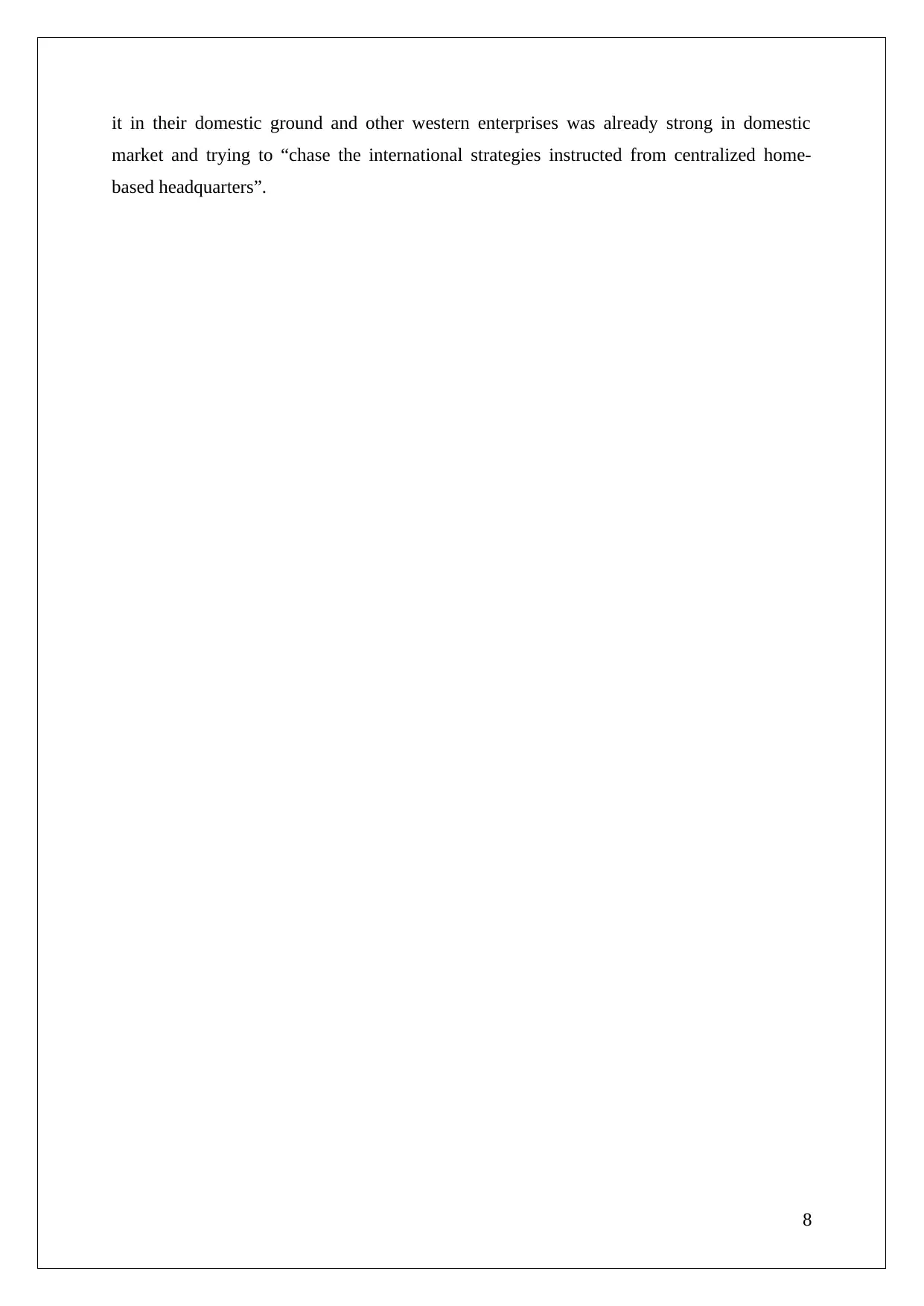
it in their domestic ground and other western enterprises was already strong in domestic
market and trying to “chase the international strategies instructed from centralized home-
based headquarters”.
8
market and trying to “chase the international strategies instructed from centralized home-
based headquarters”.
8

3. How effective has Haier’s internationalisation policy been and why?
The success story of Haier’s internationalisation policy is divided in to three stages. All the
reasons and success rate of these three stages are listed below;
Expanding market in America
After expanding market by the help of Haier’s US distributor, it penetrated niche markets in
this country. Before switching to fill sized appliances, it has focused on small refrigerators
and wine coolers. Profits from these investments has helped this company in establishing
manufacturing plants in south Carolina in 2000 and moving to its New York headquarters in
2001 (haier.net, 2018). This strategy was a great success due to the differentiation advantage
with the help of innovative product design and features based upon the particular consumer
needs and preferences.
Figure 6: Industry-wise distribution of manufacturing appliances
(Source: Hennart, 2014)
Later, this company’s product development strategy and capability in US was developed by
“the innovation of an R&D centre at its South Carolina in 2012” Next year, it has become a
main subsidiary of Haier Group. This company’s success in United Sates lies not much in the
marketing of its goods at chief rate as much as in its strategically placing of its goods (Nagle
and Müller, 2017). It incudes a amalgamation of recognizing its niche markets along with
succeeding that up with innovating products, which put up local specificities.
Developing market in Europe
In the year 2000, this company established a European sales office in Varese, Italy to
coordinate Haier’s European sales. Over the time, it transposed itself from the chief price
brand to middle of the market in which it sought out to arrest market share with the help of
design and aesthetics. After this success, Haier Europe targeted to move its headquarters to
Paris (haier.net, 2018). The success in European country lies on the importance on making
9
The success story of Haier’s internationalisation policy is divided in to three stages. All the
reasons and success rate of these three stages are listed below;
Expanding market in America
After expanding market by the help of Haier’s US distributor, it penetrated niche markets in
this country. Before switching to fill sized appliances, it has focused on small refrigerators
and wine coolers. Profits from these investments has helped this company in establishing
manufacturing plants in south Carolina in 2000 and moving to its New York headquarters in
2001 (haier.net, 2018). This strategy was a great success due to the differentiation advantage
with the help of innovative product design and features based upon the particular consumer
needs and preferences.
Figure 6: Industry-wise distribution of manufacturing appliances
(Source: Hennart, 2014)
Later, this company’s product development strategy and capability in US was developed by
“the innovation of an R&D centre at its South Carolina in 2012” Next year, it has become a
main subsidiary of Haier Group. This company’s success in United Sates lies not much in the
marketing of its goods at chief rate as much as in its strategically placing of its goods (Nagle
and Müller, 2017). It incudes a amalgamation of recognizing its niche markets along with
succeeding that up with innovating products, which put up local specificities.
Developing market in Europe
In the year 2000, this company established a European sales office in Varese, Italy to
coordinate Haier’s European sales. Over the time, it transposed itself from the chief price
brand to middle of the market in which it sought out to arrest market share with the help of
design and aesthetics. After this success, Haier Europe targeted to move its headquarters to
Paris (haier.net, 2018). The success in European country lies on the importance on making
9
⊘ This is a preview!⊘
Do you want full access?
Subscribe today to unlock all pages.

Trusted by 1+ million students worldwide
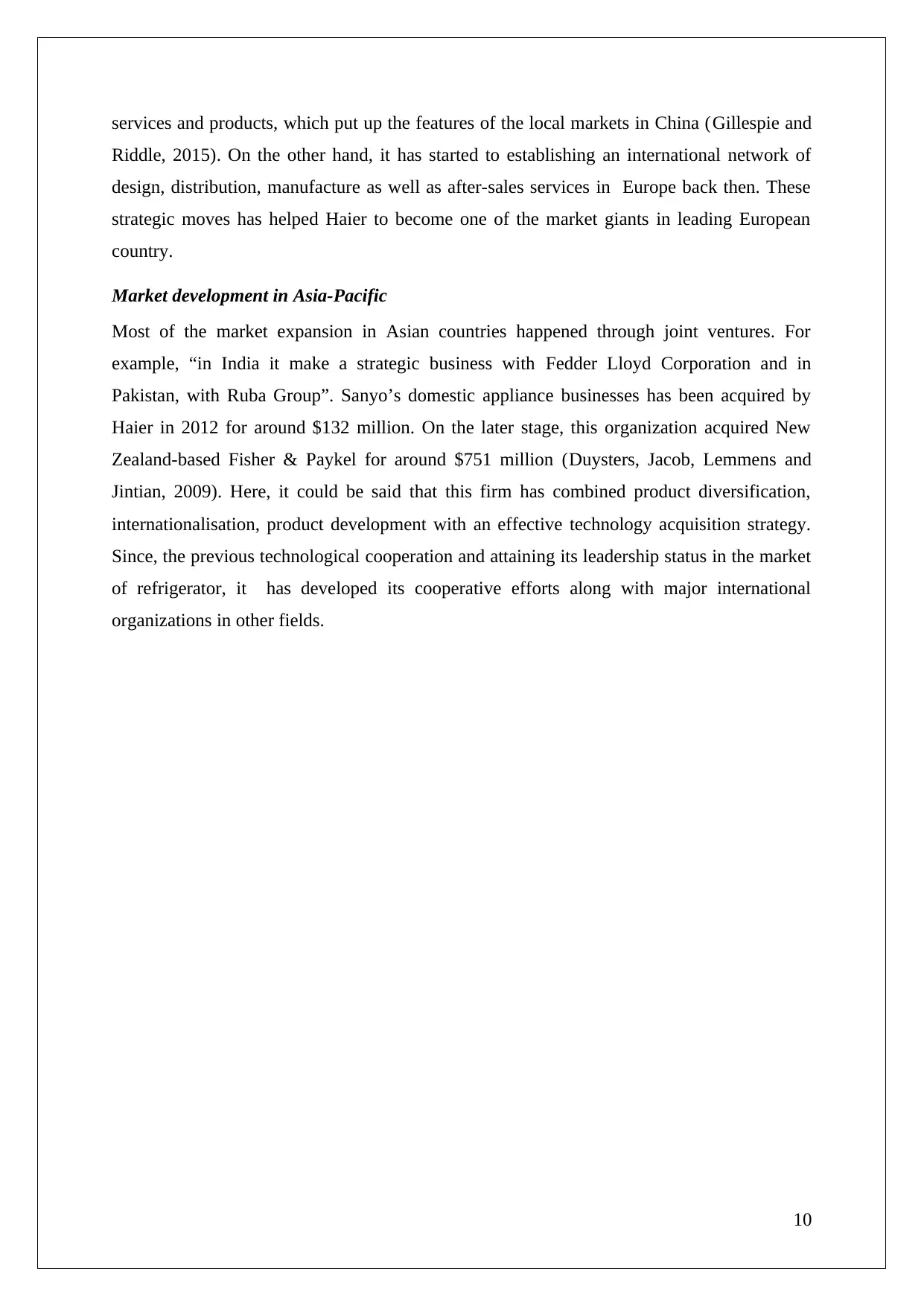
services and products, which put up the features of the local markets in China (Gillespie and
Riddle, 2015). On the other hand, it has started to establishing an international network of
design, distribution, manufacture as well as after-sales services in Europe back then. These
strategic moves has helped Haier to become one of the market giants in leading European
country.
Market development in Asia-Pacific
Most of the market expansion in Asian countries happened through joint ventures. For
example, “in India it make a strategic business with Fedder Lloyd Corporation and in
Pakistan, with Ruba Group”. Sanyo’s domestic appliance businesses has been acquired by
Haier in 2012 for around $132 million. On the later stage, this organization acquired New
Zealand-based Fisher & Paykel for around $751 million (Duysters, Jacob, Lemmens and
Jintian, 2009). Here, it could be said that this firm has combined product diversification,
internationalisation, product development with an effective technology acquisition strategy.
Since, the previous technological cooperation and attaining its leadership status in the market
of refrigerator, it has developed its cooperative efforts along with major international
organizations in other fields.
10
Riddle, 2015). On the other hand, it has started to establishing an international network of
design, distribution, manufacture as well as after-sales services in Europe back then. These
strategic moves has helped Haier to become one of the market giants in leading European
country.
Market development in Asia-Pacific
Most of the market expansion in Asian countries happened through joint ventures. For
example, “in India it make a strategic business with Fedder Lloyd Corporation and in
Pakistan, with Ruba Group”. Sanyo’s domestic appliance businesses has been acquired by
Haier in 2012 for around $132 million. On the later stage, this organization acquired New
Zealand-based Fisher & Paykel for around $751 million (Duysters, Jacob, Lemmens and
Jintian, 2009). Here, it could be said that this firm has combined product diversification,
internationalisation, product development with an effective technology acquisition strategy.
Since, the previous technological cooperation and attaining its leadership status in the market
of refrigerator, it has developed its cooperative efforts along with major international
organizations in other fields.
10
Paraphrase This Document
Need a fresh take? Get an instant paraphrase of this document with our AI Paraphraser
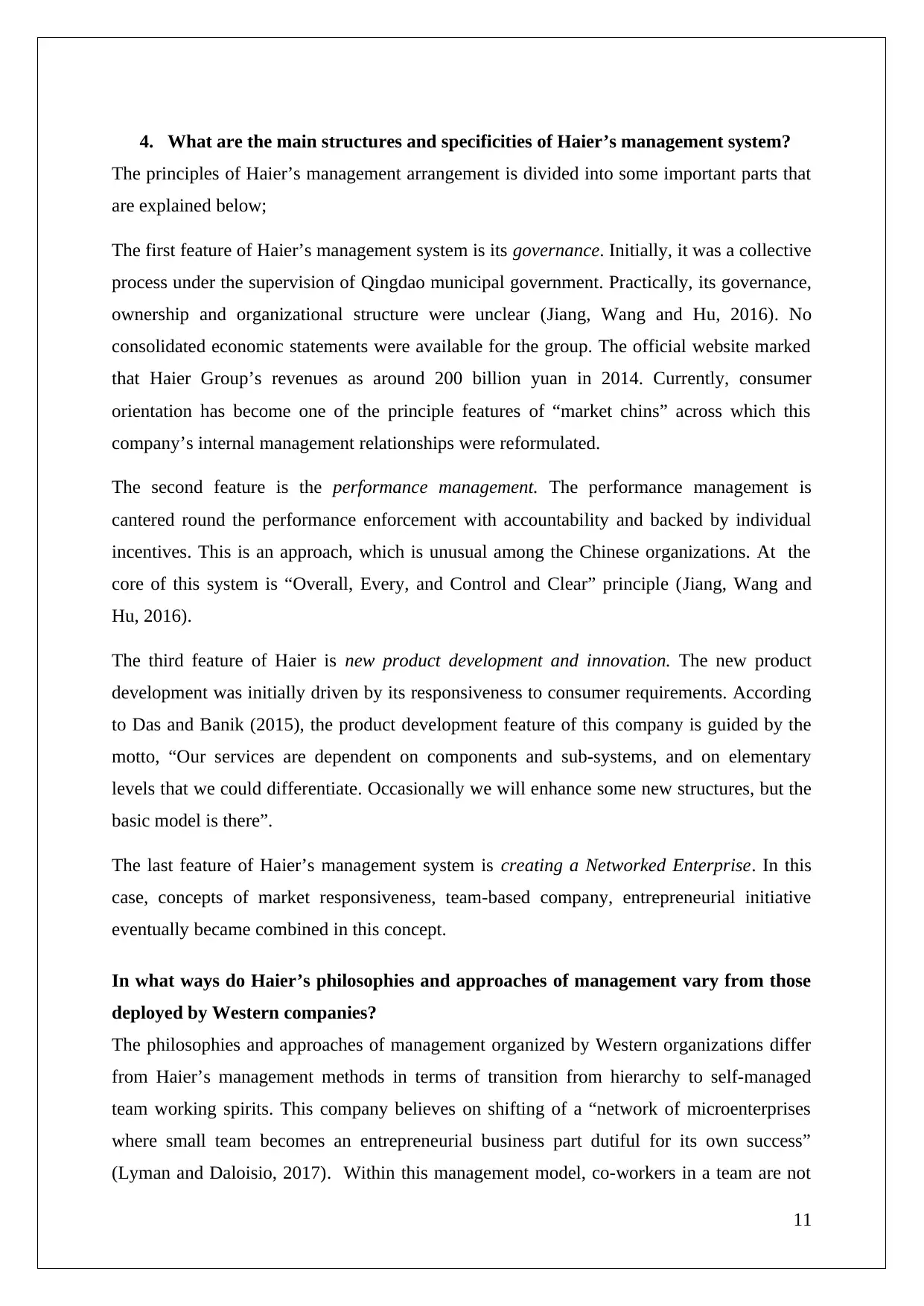
4. What are the main structures and specificities of Haier’s management system?
The principles of Haier’s management arrangement is divided into some important parts that
are explained below;
The first feature of Haier’s management system is its governance. Initially, it was a collective
process under the supervision of Qingdao municipal government. Practically, its governance,
ownership and organizational structure were unclear (Jiang, Wang and Hu, 2016). No
consolidated economic statements were available for the group. The official website marked
that Haier Group’s revenues as around 200 billion yuan in 2014. Currently, consumer
orientation has become one of the principle features of “market chins” across which this
company’s internal management relationships were reformulated.
The second feature is the performance management. The performance management is
cantered round the performance enforcement with accountability and backed by individual
incentives. This is an approach, which is unusual among the Chinese organizations. At the
core of this system is “Overall, Every, and Control and Clear” principle (Jiang, Wang and
Hu, 2016).
The third feature of Haier is new product development and innovation. The new product
development was initially driven by its responsiveness to consumer requirements. According
to Das and Banik (2015), the product development feature of this company is guided by the
motto, “Our services are dependent on components and sub-systems, and on elementary
levels that we could differentiate. Occasionally we will enhance some new structures, but the
basic model is there”.
The last feature of Haier’s management system is creating a Networked Enterprise. In this
case, concepts of market responsiveness, team-based company, entrepreneurial initiative
eventually became combined in this concept.
In what ways do Haier’s philosophies and approaches of management vary from those
deployed by Western companies?
The philosophies and approaches of management organized by Western organizations differ
from Haier’s management methods in terms of transition from hierarchy to self-managed
team working spirits. This company believes on shifting of a “network of microenterprises
where small team becomes an entrepreneurial business part dutiful for its own success”
(Lyman and Daloisio, 2017). Within this management model, co-workers in a team are not
11
The principles of Haier’s management arrangement is divided into some important parts that
are explained below;
The first feature of Haier’s management system is its governance. Initially, it was a collective
process under the supervision of Qingdao municipal government. Practically, its governance,
ownership and organizational structure were unclear (Jiang, Wang and Hu, 2016). No
consolidated economic statements were available for the group. The official website marked
that Haier Group’s revenues as around 200 billion yuan in 2014. Currently, consumer
orientation has become one of the principle features of “market chins” across which this
company’s internal management relationships were reformulated.
The second feature is the performance management. The performance management is
cantered round the performance enforcement with accountability and backed by individual
incentives. This is an approach, which is unusual among the Chinese organizations. At the
core of this system is “Overall, Every, and Control and Clear” principle (Jiang, Wang and
Hu, 2016).
The third feature of Haier is new product development and innovation. The new product
development was initially driven by its responsiveness to consumer requirements. According
to Das and Banik (2015), the product development feature of this company is guided by the
motto, “Our services are dependent on components and sub-systems, and on elementary
levels that we could differentiate. Occasionally we will enhance some new structures, but the
basic model is there”.
The last feature of Haier’s management system is creating a Networked Enterprise. In this
case, concepts of market responsiveness, team-based company, entrepreneurial initiative
eventually became combined in this concept.
In what ways do Haier’s philosophies and approaches of management vary from those
deployed by Western companies?
The philosophies and approaches of management organized by Western organizations differ
from Haier’s management methods in terms of transition from hierarchy to self-managed
team working spirits. This company believes on shifting of a “network of microenterprises
where small team becomes an entrepreneurial business part dutiful for its own success”
(Lyman and Daloisio, 2017). Within this management model, co-workers in a team are not
11
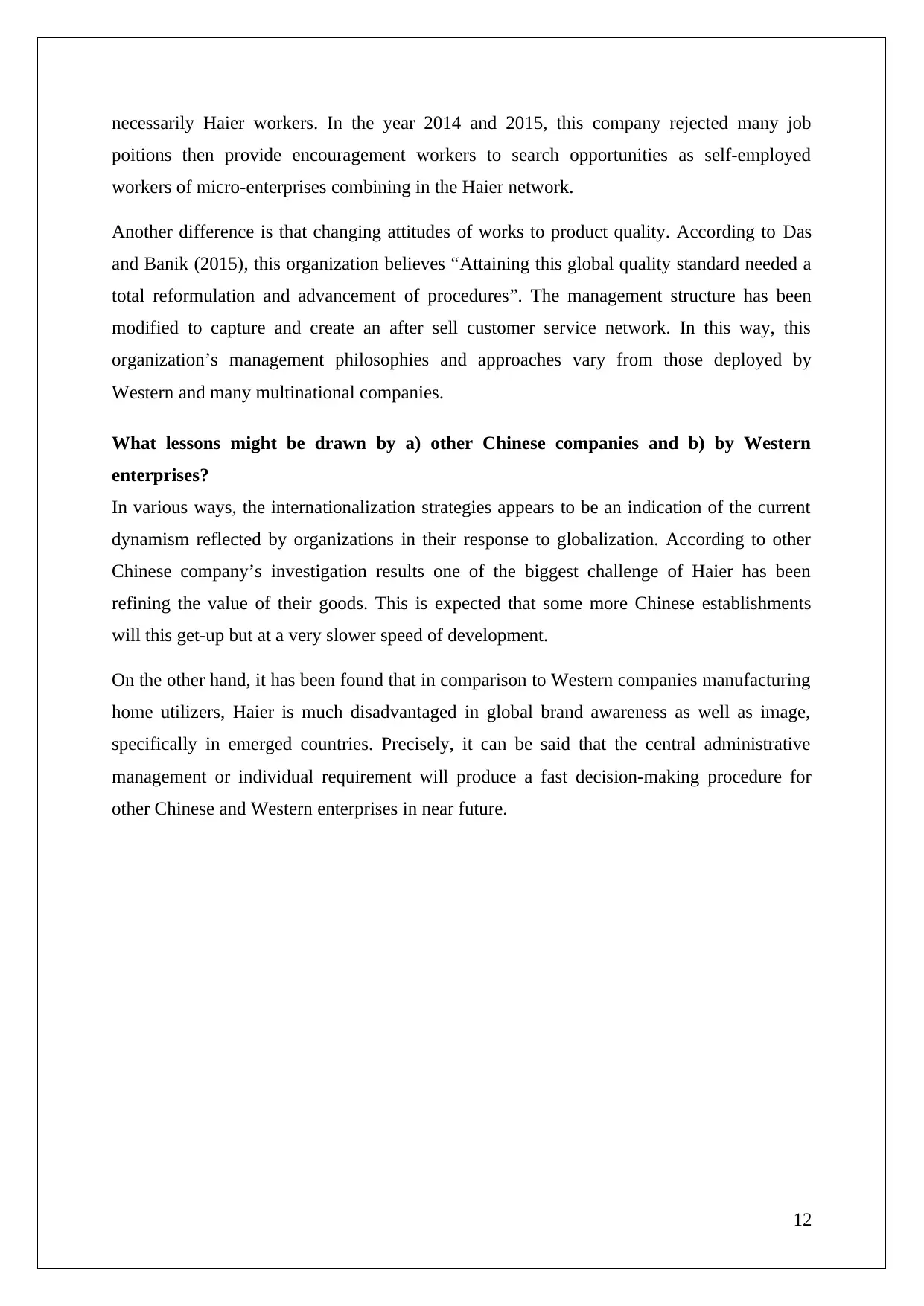
necessarily Haier workers. In the year 2014 and 2015, this company rejected many job
poitions then provide encouragement workers to search opportunities as self-employed
workers of micro-enterprises combining in the Haier network.
Another difference is that changing attitudes of works to product quality. According to Das
and Banik (2015), this organization believes “Attaining this global quality standard needed a
total reformulation and advancement of procedures”. The management structure has been
modified to capture and create an after sell customer service network. In this way, this
organization’s management philosophies and approaches vary from those deployed by
Western and many multinational companies.
What lessons might be drawn by a) other Chinese companies and b) by Western
enterprises?
In various ways, the internationalization strategies appears to be an indication of the current
dynamism reflected by organizations in their response to globalization. According to other
Chinese company’s investigation results one of the biggest challenge of Haier has been
refining the value of their goods. This is expected that some more Chinese establishments
will this get-up but at a very slower speed of development.
On the other hand, it has been found that in comparison to Western companies manufacturing
home utilizers, Haier is much disadvantaged in global brand awareness as well as image,
specifically in emerged countries. Precisely, it can be said that the central administrative
management or individual requirement will produce a fast decision-making procedure for
other Chinese and Western enterprises in near future.
12
poitions then provide encouragement workers to search opportunities as self-employed
workers of micro-enterprises combining in the Haier network.
Another difference is that changing attitudes of works to product quality. According to Das
and Banik (2015), this organization believes “Attaining this global quality standard needed a
total reformulation and advancement of procedures”. The management structure has been
modified to capture and create an after sell customer service network. In this way, this
organization’s management philosophies and approaches vary from those deployed by
Western and many multinational companies.
What lessons might be drawn by a) other Chinese companies and b) by Western
enterprises?
In various ways, the internationalization strategies appears to be an indication of the current
dynamism reflected by organizations in their response to globalization. According to other
Chinese company’s investigation results one of the biggest challenge of Haier has been
refining the value of their goods. This is expected that some more Chinese establishments
will this get-up but at a very slower speed of development.
On the other hand, it has been found that in comparison to Western companies manufacturing
home utilizers, Haier is much disadvantaged in global brand awareness as well as image,
specifically in emerged countries. Precisely, it can be said that the central administrative
management or individual requirement will produce a fast decision-making procedure for
other Chinese and Western enterprises in near future.
12
⊘ This is a preview!⊘
Do you want full access?
Subscribe today to unlock all pages.

Trusted by 1+ million students worldwide
1 out of 15
Related Documents
Your All-in-One AI-Powered Toolkit for Academic Success.
+13062052269
info@desklib.com
Available 24*7 on WhatsApp / Email
![[object Object]](/_next/static/media/star-bottom.7253800d.svg)
Unlock your academic potential
Copyright © 2020–2025 A2Z Services. All Rights Reserved. Developed and managed by ZUCOL.



